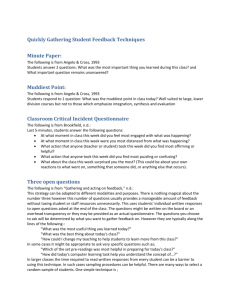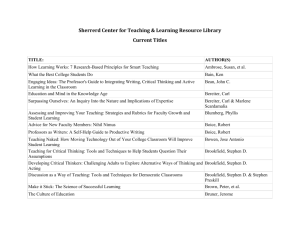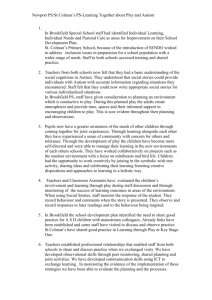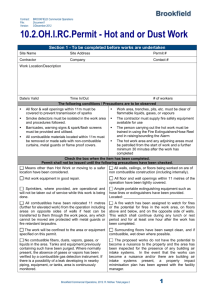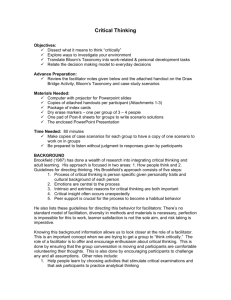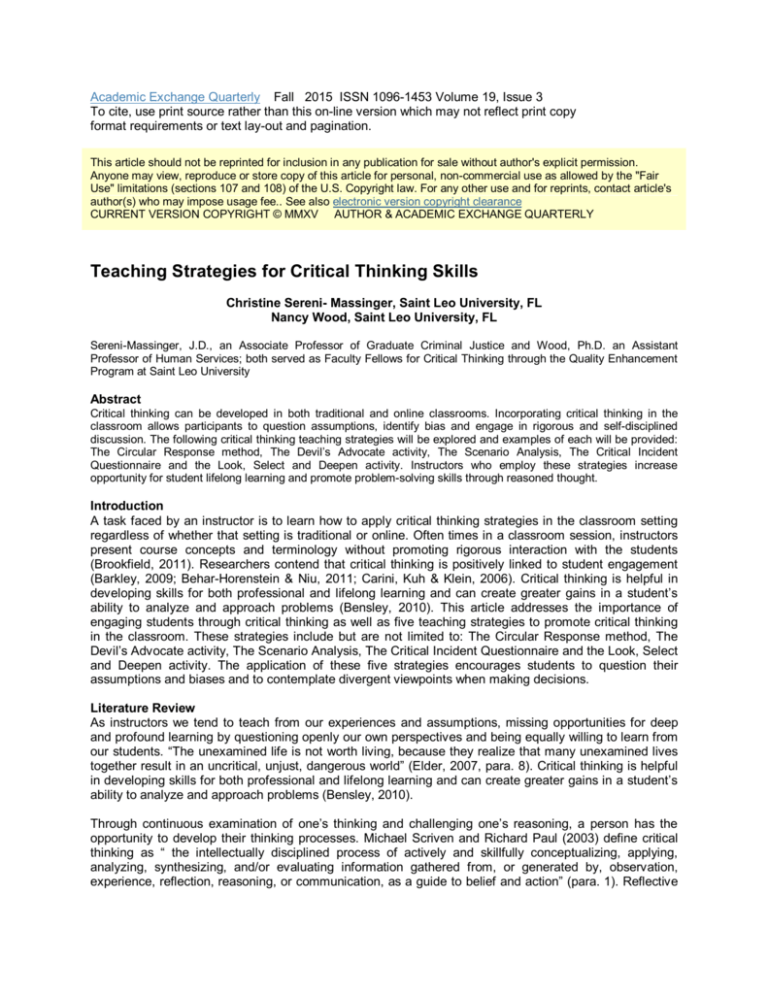
Academic Exchange Quarterly Fall 2015 ISSN 1096-1453 Volume 19, Issue 3
To cite, use print source rather than this on-line version which may not reflect print copy
format requirements or text lay-out and pagination.
This article should not be reprinted for inclusion in any publication for sale without author's explicit permission.
Anyone may view, reproduce or store copy of this article for personal, non-commercial use as allowed by the "Fair
Use" limitations (sections 107 and 108) of the U.S. Copyright law. For any other use and for reprints, contact article's
author(s) who may impose usage fee.. See also electronic version copyright clearance
CURRENT VERSION COPYRIGHT © MMXV AUTHOR & ACADEMIC EXCHANGE QUARTERLY
Teaching Strategies for Critical Thinking Skills
Christine Sereni- Massinger, Saint Leo University, FL
Nancy Wood, Saint Leo University, FL
Sereni-Massinger, J.D., an Associate Professor of Graduate Criminal Justice and Wood, Ph.D. an Assistant
Professor of Human Services; both served as Faculty Fellows for Critical Thinking through the Quality Enhancement
Program at Saint Leo University
Abstract
Critical thinking can be developed in both traditional and online classrooms. Incorporating critical thinking in the
classroom allows participants to question assumptions, identify bias and engage in rigorous and self-disciplined
discussion. The following critical thinking teaching strategies will be explored and examples of each will be provided:
The Circular Response method, The Devil’s Advocate activity, The Scenario Analysis, The Critical Incident
Questionnaire and the Look, Select and Deepen activity. Instructors who employ these strategies increase
opportunity for student lifelong learning and promote problem-solving skills through reasoned thought.
Introduction
A task faced by an instructor is to learn how to apply critical thinking strategies in the classroom setting
regardless of whether that setting is traditional or online. Often times in a classroom session, instructors
present course concepts and terminology without promoting rigorous interaction with the students
(Brookfield, 2011). Researchers contend that critical thinking is positively linked to student engagement
(Barkley, 2009; Behar-Horenstein & Niu, 2011; Carini, Kuh & Klein, 2006). Critical thinking is helpful in
developing skills for both professional and lifelong learning and can create greater gains in a student’s
ability to analyze and approach problems (Bensley, 2010). This article addresses the importance of
engaging students through critical thinking as well as five teaching strategies to promote critical thinking
in the classroom. These strategies include but are not limited to: The Circular Response method, The
Devil’s Advocate activity, The Scenario Analysis, The Critical Incident Questionnaire and the Look, Select
and Deepen activity. The application of these five strategies encourages students to question their
assumptions and biases and to contemplate divergent viewpoints when making decisions.
Literature Review
As instructors we tend to teach from our experiences and assumptions, missing opportunities for deep
and profound learning by questioning openly our own perspectives and being equally willing to learn from
our students. “The unexamined life is not worth living, because they realize that many unexamined lives
together result in an uncritical, unjust, dangerous world” (Elder, 2007, para. 8). Critical thinking is helpful
in developing skills for both professional and lifelong learning and can create greater gains in a student’s
ability to analyze and approach problems (Bensley, 2010).
Through continuous examination of one’s thinking and challenging one’s reasoning, a person has the
opportunity to develop their thinking processes. Michael Scriven and Richard Paul (2003) define critical
thinking as “ the intellectually disciplined process of actively and skillfully conceptualizing, applying,
analyzing, synthesizing, and/or evaluating information gathered from, or generated by, observation,
experience, reflection, reasoning, or communication, as a guide to belief and action” (para. 1). Reflective
dialogue between instructor and students will hasten the acquirement of skills and knowledge, while
cultivating critical thinking to address complex problems (Yang, Newby & Bill, 2008).
A model approach is provided by Paul and Elder in order to guide in the development and enhancement
of critical thinking. The framework Paul and Elder (2010) provide includes a list of elements; purpose,
information, concepts, assumptions, inferences/conclusions, points of view, questions and
implications/consequences, which is included in their critical thinking framework. The Paul-Elder Critical
Thinking Model includes a list of intellectual standards that must be applied to the list of elements that
leads to the development of intellectual traits.
In Stephen Brookfield’s book Teaching for Critical Thinking, he conceives the following definition for
critical thinking as “1) identifying the assumptions that frame our thinking and determine our actions 2)
checking out the degree to which these assumptions are accurate and valid 3) looking at our ideas and
decisions from several different perspectives 4) on the basis of this making informed decisions” (2011,
para. 1). Brookfield further states, “critical thinking is necessary for personal survival …it is a lived reality
pressing in on us in the shifting contexts of the personal, occupational and political changes we
experience” (pp. 20-21).
Nosich (2012) explains that critical thinking includes various pertinent features; being reflective, involving
standards, being authentic, and being reasonable. He further breaks critical thinking into three stages;
asking the right questions; trying to answer the questions by reasoning; and believing the results of the
reasoning. Discussion and problem-solving can be critical thinking opportunities when students are
provided the occasion to exchange ideas, address the reasoning being provided, identify the points of
view being conveyed and recognize the problem that needs to be solved.
In her book Thought and Knowledge, Diane Halpern (2003) refers to critical thinking as direct thinking
because it often focuses on a desired outcome. With the use of cognitive skills and strategies, critical
thinking will likely lead to a positive outcome. Specifically, critical thinking is purposeful, goal directed and
reasoned which involves problem solving, formulating inferences, making thoughtful decisions, and
calculating probable outcomes.
Research has shown that a student’s critical thinking ability seems to develop when the learning
environment includes the challenge or confrontation of one’s belief system, the encouragement to reflect
upon that belief system, the creation of cognitive puzzlement and the guidance to actively problem solve
(Angeli & Valanides, 2009). Kirschner, Sweller, and Clark (2006) concluded that instruction guidance
problem solving is more effective that unstructured problem solving. To encourage the development of
critical thinking skills, students must be motivated and provided direct instruction (Bensley, 2010).
Instructors are often looking for strategies that may be helpful in developing critical thinking skills of their
students.
Discussion
Critical thinking can be developed and fostered both in the traditional classroom setting as well as the
online classroom setting with a series of five teaching strategies that can assist the student to expand
their thinking, identify their bias and question their assumptions. These strategies are: The Circular
Response method, The Devil’s Advocate activity, The Scenario Analysis, The Critical Incident
Questionnaire and the Look, Select and Deepen activity. Research has shown that critical thinking is
effective both as a separate course as well as a topic embedded in specific subject matters (Abrami et al.,
2008; Behar-Horenstein & Niu, 2011; Toy & Ok, 2012; Wood & Miller, 2014). The following critical
thinking teaching strategies can be incorporated in most subject matter content:
The Circular Response Method
In order to question an assumption the student must first identify the assumption, then, the accuracy and
validity of the assumption can be analyzed. The Circular Response method can be used both in the
traditional setting as well as the online setting (Brookfield, 2011). This method is also effective in creating
a sense of community in the classroom even though the participants often have varied backgrounds
(Barkley, 2009).
According to this method the student speaker (or writer in the online setting) must incorporate a comment
that was referred to by the prior student by either agreeing or disagreeing with the prior student’s
statement and providing their reasons why. The communication continues around either a real circle of
discussion (in the traditional classroom) or an assigned circle of discussion (online). The teaching
strategy allows for each student to reflect on their colleagues’ opinions and thoughts while presenting
reasons for challenging or not challenging them. The strategy helps to scaffold each student’s learning by
encouraging each student to identify what it is about the prior statement that they agree with or disagree
with and to find supporting arguments for their positions.
This strategy is effective in many disciplines in that it promotes acceptance of differences in opinion. Also,
this method can be used with multiple issues of discussion in the classroom setting. Whether it is a
discussion regarding the effectiveness of punitive criminal sentencing or a discussion regarding the cause
of global warming, students are requested to offer their opinions one by one and then to agree or
disagree with the opinion that immediately preceded their turn. At the end of the circular response the
students discuss their views and reveal whether they were persuaded by their colleagues to change their
position. Researchers contend that creating an educational climate, in which differences of opinion are
not only discussed, but also appreciated, may help to propel social and economic advances (Cockell,
McArthur-Blair, & Schiller, 2012).
Devil’s Advocate Activity
A second teaching strategy that examines the difference between bias thought and reasonable thought is
the Devil’s Advocate activity. This teaching strategy can be structured by having the student act as their
own devil’s advocate wherein they present a hypothesis and then challenge their own hypothesis. It can
also be structured wherein another student acts as the devil’s advocate. If the latter is selected, each
student takes a position on an issue and presents arguments pro or con on that issue. The challenger is
then asked to argue the opposite of that position (Brookfield, 2011).
One way that this can be accomplished is to have the first student take the opposite position of what they
truly believe. Interestingly, many times, as the student is arguing the position that they did not initially
accept, they start to believe that position through their own argument. At the end of the challenge the
teacher can inquire whether they argued the position they believed in or not. Often times, the answer is
surprising to all, as the student has accepted the other argument through addressing that position. This
type of debate permits students to examine the pros and cons of their positions while thoroughly listening
to and examining the alternative position. The employment of this strategy in the classroom assists
students in analyzing and evaluating their biases. It also assists them in contemplating divergent points of
view (Overbaugh & Schultz, 2010).
In the on ground classroom two chairs can be placed in the front of the class. Each student takes a place
in their chair and faces the other student. One student chooses one side of the argument and then the
other student argues the opposite position. This can be done with many controversial issues (the death
penalty, abortion, historical political decisions such as the declaration of war.) This strategy can also be
achieved in less controversial topics such as the effectiveness of traffic lights or the soothing appeal of
classical music. Regardless of the topic, it is the open-ended nature of the question that allows for deep
and rigorous discussion (Brookfield, 2011).
The Scenario Analysis
A third strategy that is effective in examining biases and assumptions is the Scenario Analysis. In this
strategy, the teacher presents a fictional or real story and asks the students to imagine that they are the
main character. First, the students are asked to create a list of the assumptions of the main character.
Second, they are asked which of these assumptions can be verified by research or inquiry. Lastly, they
are asked to give an alternate view of the scenario based on issues that the main character has not taken
into consideration. In this strategy, the student becomes aware of their biases and prejudgments and also
delves into their ability to be empathetic in order to build their emotional quotient (Brookfield, 2011).
This strategy can be adapted to almost every subject and topic by writing a fictional story in which a
character is making decisions that can be analyzed by the class. An example of a Scenario Analysis is a
fictional psychologist who makes a diagnosis of a fictional patient. Students are then asked what
assumptions the psychologist made in his/her diagnosis. Were these assumptions based on research and
trained inquiry? Do the students agree with the diagnosis? Lastly, the students are asked to discuss some
issues that the fictional psychologist has not taken into consideration that might change the outcome of
the scenario (Brookfield, 2011). This teaching strategy develops students’ intellectual empathy in that it
examines whether emotion is embedded in our decision-making and the decision making of others. Some
researchers posit that encouraging students to reason and to develop intellectual empathy is the key to
critical thinking (Linker, 2012).
Critical Incident Questionnaire
The practice of reflective thinking wherein innate biases are challenged is also mastered by such
strategies as the Critical Incident Questionnaire (CIQ). There are two ways the CIQ can be used. First,
the CIQ can be used to analyze a position or argument. The student is asked to present an argument and
then to follow that argument with an assumption challenge or assumption audit. In so doing, the teacher
explores with the students the reasons why they are taking a particular position or have a particular
perspective regarding their argument, and challenges them to question what is just and fair in their
thinking and what is biased (Brookfield & James, 2014).
The Critical Incident Questionnaire can also be used to analyze the classroom environment and as an
assessment tool for learning. Before the end of class an instructor can provide the students with a list of
questions such as: 1) At what moment in the class were you most engaged? 2) At what moment did you
feel most distanced as a learner? 3) What action in the classroom did you find most helpful? Involving
students in the critique of their learning process serves to actively engage them and assists instructors in
the development and presentation of future content (Adams, 2009).
Look, Select, Deepen
Another teaching strategy that can be implemented to examine views and encourage deep reflection of
thought is the LSD. The acronym stands for Look, Select, Deepen. First, Look back through what has
been learned, then Select that learning which you wish to prioritize, and finally Deepen the learning by
determining what was learned which is worthy of guiding future thought and action (Brookfield & James,
2014). This strategy is effective for not only examining reasons for past thought but also prepares the
student to think through future dilemmas and challenges as well.
The strategy is presented in three steps: 1) In the Look back stage the instructor requests the students to
immerse themselves in examining their work product and to appraise its relevance 2) In the Select stage
the instructor encourages the student to be mindful of what they should discard, keep or prioritize in that
learning 3) In the Deepen stage the instructor encourages the student to develop that which they believe
to be a priority (Brookfield & James, 2014). The strategy can be used with multiple issues and across
many disciplines. For example in the nursing field it can been used to determine what actions should take
place to achieve a specific outcome for the patient and what priorities for planning should be set to
accomplish patient needs within a specific time frame (Yildirim & Ozkahraman, 2011).
The utilization of the above teaching strategies can be helpful in the process of addressing the
development of students’ critical thinking skills for professional and lifelong learning. Brookfield (2011)
focuses on the relevance of a learner’s cumulative lifetime experiences and the reservoir of information
which they can draw from to address a problem. Other researchers agree that integrating critical thinking
in the adult classroom allows students to draw questions from the sum of their experiences and to test
those claims, whether it is in a personal or a professional context (Mezirow, 2012). Research has shown
that first year college students have benefited as much from instruction on critical thinking as have higher
level college students and graduate students; hence the difference in educational level is not indicative of
student receptiveness and success in this type of learning (Tiruneh, Verburgh & Elen, 2014).
Conclusion
Critical Thinking is a skill that can be taught in both the traditional and online classroom. It is clear from
the five strategies discussed, that the emphasis of critical thinking in the classroom involves time, skill,
and dedication. Critical thinking is a process, methodical in nature and calls for a higher level of thinking
beyond recall. With the implementation of such strategies as the Circular Response, Devil’s Advocate,
Scenario Analysis, Look Select and Deepen Activity and the Critical Incident Questionnaire, students can
be encouraged to live an examined life by questioning assumptions, re-thinking biases and entertaining
divergent points of view. Engaging students in critical thinking encourages interaction and allows a
platform for meaningful and rigorous discussion that leads to life long learning.
References
Abrami, P. C., Bernard, R. M., Borokhovski, E., Wade, A., Surkes, M., Tamim, R., & Zhang, D.
(2008). Instructional interventions affecting critical thinking skills and dispositions: A
stage 1 meta-analysis. Review of Educational Research, 78(4), 1102-1134. Retrieved
from http://dx.doi.org/10.3102/0034654308326084.
Adams, K. L. (2001). The Critical incident questionnaire: A Reflective teaching
tool. Exchanges: The Online Journal of Teaching and Learning in the CSU (2001).
Retrieved from http://www.exchangesjournal.org/print/print_1038.html.
Angeli, C., & Valanides, N. (2009). Instructional effects on critical thinking: Performance on illdefined
issues.
Learning
and
Instruction,
19(4),
322-334.
http://dx.doi.org/10.1016/j.learninstruc.2008.06.010
Barkley, E.F. (2009). Student engagement techniques: A Handbook for college faculty. San
Francisco, CA: Jossey-Bass.
Behar-Horenstein, L.S., & Niu, L. (2011). Teaching critical thinking skills in higher education: A
review of the literature. Journal of College Teaching & Learning, 8(2), 25-42.
Bensley, D.A. (2010). A Brief guide for teaching and assessing critical thinking in psychology.
Observer, 23(10).
Brookfield, S.D. (2011). Teaching for critical thinking: Tools and techniques to help students
question their assumptions. San Francisco, CA: John Wiley & Sons.
Brookfield, S.D. & James, A. (2014). Engaging imagination, helping student to become
reflective thinkers. San Francisco: Jossey-Bass.
Carini, R.M., Kuh, G.D., & Klein, S.P. (2006). Student Engagement and Student Learning:
Testing the Linkages. Research in Higher Education, 47(1), 1-32.
Cockell, J., McArthur-Blair, J., & Schiller, M. (2012). Appreciate inquiry in higher education: A
Transformative force. San Francisco, CA: Jossey-Bass.
Elder, L. (2007, Sept). The Critical thinking community. Defining critical thinking. Retrieved
from http://www.criticalthinking.org/pages/defining-critical-thinking/766
Halpern, D. (2003). Thought and knowledge: An Introduction to critical thinking. Mahwah, NJ:
Erlbaum Associates.
Kirschner, P. A., Sweller, J., & Clark, R. E. (2006). Why minimal guidanceduring instruction
does
not work: an analysis of the failure of constructivist, discovery, problembased, experiential, and inquiry-based teaching. Educational Psychologist, 41(2), 7586.
Linker, M. (2012). Intellectual empathy critical thinking for social justice. Ann Arbor: MI:
University
of
Michigan
Press.
Retrieved
from
http://www.press.umich.edu/8024224/intellectual_empathy#sthash.naSeowXL.dpuf
Mezirow, J. (2012). Learning to think like an adult: Core concepts of transformation theory. In
E.W. Taylor, P. Cranton and Associates, The Handbook of Transformative Learning:
Theory, Research and Practice, 73 – 95. San Francisco, CA: Jossey-Bass.
Nosich, G. (2012). Learning to think things through. A Guide to critical thinking across the
curriculum. (4th ed). Boston, MA: Pearson.
Overbaugh, R. & Schultz, L. (2010). Bloom’s Taxonomy. Old Dominion University.
http://ww2.odu.edu/educ/roverbau/Bloom/blooms_taxonomy.htm
Paul, R. & Elder, L. (2010). The Miniature Guide to Critical Thinking Concepts and Tools. Dillon
Beach, CA: Foundation for Critical Thinking Press.
Scriven, M. & Paul, R. (2003). The Critical Thinking Community. Defining critical thinking.
Retrieved from http://www.criticalthinking.org/pages/defining-critical-thinking/410
Tiruneh, D., Verburgh, A. & Elen, J. (2014). Effectiveness of critical thinking instruction in higher
education: A Systematic review of intervention studies. Higher Education Studies, 4(1).
Retrieved http://www.ccsenet.org/journal/index.php/hes/article/viewFile/32095/193
Toy, B. & Ok, A. (2012). Incorporating critical thinking in the pedagogical content of a teacher
education programme: Does it make a difference? European Journal of Teacher
Education,35(1),39-56. Retrieved http://dx.doi.org/10.1080/02619768.2011.634902
Wood, N. & Miller, J. (2014) Perspectives on argument. (8th ed.). United Kingdom. Pearson
Longman.
Yang, Y., Newby, T., & Bill, R. (2008). Facilitating interactions through structured web-based
bulletin boards: A quasi-experimental study on promoting learners’ critical thinking
skills.
Computers
&
Education,
50(4),
1572-1585.
Retrieved
from
http://dx.doi.org/10.1016/j.compedu.2007.04.006
Yildirim, B. & Ozkahraman, S. (2011, Sept). Critical thinking in nursing process and education
international journal of humanities and social science, 1(13).
Retrieved from http://www.ijhssnet.com/journals/Vol_1_No_17
_Special_Issue_November_2011/19.pdf

